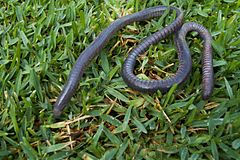Marszczelcowate
Wygląd
| Caeciliidae | |||||
| Rafinesque, 1814 | |||||
 Przedstawiciel rodziny – Oscaecilia ochrocephala | |||||
| Systematyka | |||||
| Domena | |||||
|---|---|---|---|---|---|
| Królestwo | |||||
| Typ | |||||
| Podtyp | |||||
| Gromada | |||||
| Rząd | |||||
| Rodzina |
marszczelcowate | ||||
| |||||
| Rodzaje | |||||
| |||||
Marszczelcowate (Caeciliidae) – rodzina płazów z rzędu płazów beznogich (Gymnophiona).
Zasięg występowania
[edytuj | edytuj kod]Rodzina obejmuje gatunki występujące w Kostaryce i Panamie poprzez północną Amerykę Południową na południe do Boliwii, południowej Brazylii i prawdopodobnie Paragwaju[26].
Charakterystyka
[edytuj | edytuj kod]Posiadają długie, robakowate ciało, podzielone fałdami skórnymi na pierścienie. Brak nóg. Między oczami i nozdrzem para czułków (prawdopodobnie narządy zmysłu smaku i węchu). Otwór gębowy na spodzie głowy. Gruczoły jadowe w skórze. Mieszkają pod ziemią, mięsożerne. Osiągają zwykle długość 40–60 cm, wyjątkowo do 130 cm.
Systematyka
[edytuj | edytuj kod]Do rodziny marszczelcowatych należą następujące rodzaje[26]:
- Caecilia Linnaeus, 1758
- Oscaecilia Taylor, 1968
Przypisy
[edytuj | edytuj kod]- ↑ N.M. Oppel: Die ordnungen, familien und gattungen der reptilien als prodrom einer naturgeschichte derselben. München: Joseph Lindauer, 1811, s. 72. (niem.).
- ↑ C.S. Rafinesque. Fine del Prodromo d’Erpetologia Siciliana. „Specchio delle Scienze, o, Giornale Enciclopedico di Sicilia”. 2, s. 104, 1811. (wł.).
- ↑ J.E. Gray. A synopsis of the genera of reptiles and Amphibia, with a description of some new species. „Annals of Philosophy”. New Series. 10, s. 217, 1825. (ang.).
- ↑ L. Fitzinger: Neue Classification der Reptilien nach ihren Natürlichen Verwandtschaften nebst einer Verwandtschafts-Tafel und einem Verzeichnisse der Reptilien-Sammlung des K. K. Zoologisch Museum’s zu Wien. Wien: J.G. Heubner, 1826, s. 63. (niem.).
- ↑ J.G. Wagler. Vorläufige Uebersicht des Geruftes, sowie Untungigung feines Systema amphibiorum. „Isis von Oken”. 21, s. 859, 1828. (niem.).
- ↑ C.E. von Eichwald: Zoologia Specialis, quam Expositis Animalis tum Vivis, tum Fossilibus potossimum Rossiae in Universum, et Poloniae in Species, in Usum Lectionum Publicarum in Universitate Caesarea Vilnensi habendarum edidit. T. 3. Vilnius: Josophi Zawadski, 1831, s. 177. (łac.).
- ↑ Ch.-L. Bonaparte: Saggio d’una Distribuzione Metodica degli Animali Vertebrati sangue freddo. Rome: Antonio Boulzaler, 1832, s. 9. (wł.).
- ↑ H.R. Schinz: Naturgeschichte und Abbildungen der Reptilien. Schaffhausen: Brodtmanns lithographischer Kunstanstalt, 1833, s. 195. (niem.).
- ↑ Ch.-L. Bonaparte. Systema Amphibiorum. „Mémoires de la Société des sciences naturelles de Neuchâtel”. 2, s. 16, 1839. (łac.).
- ↑ J. Hogg. On the classification of the Amphibia. „Magazine of Natural History”. New Series. 3, s. 273, 1839. (ang.).
- ↑ Ch.-L. Bonaparte. Amphibia Europaea and systema nostrum vertebratorum ordinata. „Memoria. Reale Accademia delle Scienze di Torino”. Serie Seconda. 2, s. 394, 1840.
- ↑ A.M.C. Duméril & G. Bibron: Erpétologie Genérale ou Histoire Naturelle Complète des Reptiles. Cz. 8. Paris: Roret, 1841, s. 53. (fr.).
- ↑ F.H. Troschel: Versuch einer Zusammenstellung der Fauna und Flora von Britisch-Guiana. W: R. Schomburgk (red.): Reisen in Britisch-Guiana in den Jahren 1840–44. Im Auftrage Sr. Majestät des Königs von Preussen ausgeführt. Cz. 3. Leipzig: J.J. Weber, s. 661. (niem.).
- ↑ Ch.-L. Bonaparte: Conspectus Systematum. Herpetologiae et Amphibiologiae. Wyd. Editio altera reformata. Lugdini Batavorum: E.J. Brill, 1850, s. 1. (łac.).
- ↑ C.A. Bruch. Beiträge zur Naturgeschichte und Classification der nackten Amphibien. „Würzburger Naturwissenschaftliche Zeitschrift”. 3, s. 221, 1862. (niem.).
- ↑ W.M. Keferstein. Über einige neue oder seltene Batrachier aus Australien und dem tropischen Amerika. „Nachrichten von der Georg-Augusts-Universität und der Königl. Gesellschaft der Wissenschaften zu Göttingen”. 18, s. 361, 1867. (niem.).
- ↑ G.A. Boulenger. Description of new species of reptiles and batrachians in the British Museum. „The Annals and Magazine of Natural History”. Fifth Series. 12, s. 166, 1883. (ang.).
- ↑ A. Dubois. Miscellanea nomenclatorica batrachologica (V). „Alytes”. 3, s. 114, 1984. (ang.).
- ↑ A. Dubois. Miscellanea nomenclatorica batrachologica (VII). „Alytes”. 4, s. 71, 1985. (ang.).
- ↑ Lescure, Renous i Gasc 1986 ↓, s. 163.
- ↑ a b c Lescure, Renous i Gasc 1986 ↓, s. 167.
- ↑ a b c Lescure, Renous i Gasc 1986 ↓, s. 168.
- ↑ Anonimowy. Opinion 1462. Caeciliidae Rafinesque-Schmaltz, 1814 (Amphibia, Gymnophiona) and Caeciliidae Kolbe, 1880 (Insecta, Psocoptera): a ruling to remove homonymy. „Bulletin of Zoological Nomenclature”. 44, s. 263, 1987. (ang.).
- ↑ S.B. Hedges, R.A. Nussbaum & L.R. Maxson. Caecilian phylogeny and biogeography inferred from mitochondrial DNA sequences of the 12s rRNA and 16S rRNA genes (Amphibia: Gymnophiona). „Herpetological Monographs”. 7, s. 63–76, 1993. DOI: 10.2307/1466952. (ang.).
- ↑ Anonimowy. Opinion 1830. Caeciliidae Kolbe, 1880 (Insecta, Psocoptera): Spelling emended to Caeciliusidae, so removing the homonymy with Caeciliidae Rafinesque, 1814 (Amphibia, Gymnophiona). „Bulletin of Zoological Nomenclature”. 53, s. 68–69, 1996. (ang.).
- ↑ a b D. Frost: Caeciliidae Rafinesque, 1814. [w:] Amphibian Species of the World 6.2, an Online Reference [on-line]. American Museum of Natural History. [dostęp 2023-07-31]. (ang.).
Bibliografia
[edytuj | edytuj kod]- J. Lescure, S. Renous & J.-P. Gasc. Proposition d’une nouvelle classification des amphibiens gymnophiones. „Mémoires de la Société Zoologique de France”. 43, s. 145–177, 1986. (fr.).
